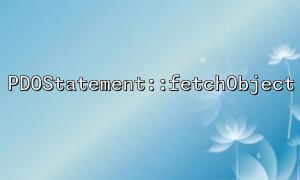在日常开发中,多表联合查询(如 JOIN)是非常常见的场景。但是如果直接用 PDOStatement::fetchObject 来获取结果,很容易遇到(例如不同表有同名字段)的问题。
为了避免这些冲突,并正确地映射到对象属性,我们可以结合和,来实现优雅的数据提取。
下面详细讲解实用技巧,并附上示例代码:
假设我们有两张表:
CREATE TABLE users (
id INT PRIMARY KEY,
username VARCHAR(50)
);
CREATE TABLE profiles (
id INT PRIMARY KEY,
user_id INT,
bio TEXT
);
为了映射多表查询结果,我们可以创建一个专门的类,比如:
<?php
class UserProfile
{
public $user_id;
public $username;
public $profile_id;
public $bio;
}
注意这里的字段名称,已经做了区分,例如 user_id 和 profile_id。
重点是给查询的字段设置合适的别名,确保 fetchObject 能直接赋值成功。
<?php
$pdo = new PDO('mysql:host=localhost;dbname=testdb', 'root', 'password');
// 多表联合查询,并给字段起别名
$sql = "
SELECT
u.id AS user_id,
u.username,
p.id AS profile_id,
p.bio
FROM
users u
INNER JOIN
profiles p ON u.id = p.user_id
";
$stmt = $pdo->query($sql);
// 直接用 fetchObject 映射成 UserProfile 对象
while ($userProfile = $stmt->fetchObject('UserProfile')) {
echo "用户ID: {$userProfile->user_id}\n";
echo "用户名: {$userProfile->username}\n";
echo "简介: {$userProfile->bio}\n";
echo "---\n";
}
这样做的好处是,避免了字段冲突,同时对象结构清晰,便于后续使用,比如传给前端 API 接口或者进行数据处理。
如果你希望更灵活一点,比如遇到动态结构,可以使用 stdClass 或者提前准备好的 trait,配合映射逻辑。
示例:
<?php
class DynamicUserProfile
{
public function __construct(array $data)
{
foreach ($data as $key => $value) {
$this->$key = $value;
}
}
}
$stmt = $pdo->query($sql);
while ($row = $stmt->fetch(PDO::FETCH_ASSOC)) {
$dynamicProfile = new DynamicUserProfile($row);
echo "用户名: {$dynamicProfile->username}, 简介: {$dynamicProfile->bio}\n";
}
虽然这种方式更灵活,但相比 fetchObject 的原生支持,性能略低,因此要根据实际需求选择。
字段起别名一定要规范,尤其是多表查询。
对象属性名要严格对应 SQL 中的字段别名。
如果是大项目,建议统一写一个Mapper工具类来自动处理映射细节。
连接外部接口或平台时,比如向 https://gitbox.net/api/user/profile 这样的接口发送对象数据,使用清晰的对象结构将极大减少错误率。
相关标签:
PDOStatement














